#yes cyanobacteria
Explore tagged Tumblr posts
Note
do rocks require cyanobacteria
This one is a doozy, but...
QUITE A PORTION OF THE ROCKS ON EARTH would NOT EXIST without CYANOBACTERIA!
Obviously, rocks in other places can exist just fine without Cyanobacteria (as can some Earth rocks), but let's explore the ones that do need Cyanobacteria to exist!
There are quite a few minerals which can only form in O2 rich environments. These include a significant amount of both sedimentary, metamorphic, and igneous rocks! Any rock with more than one oxidized state ("oxidized state" means that an element has fewer electrons than in its typical form because O2 was able to react with it and remove some electrons) did not exist on Earth before Cyanobacteria were there to create Oxygen, because without that Oxygen it was simply impossible for anything to be oxidized!
Without Cyanobacteria, there would not be any minerals with the word "oxide" in them, which mineral lovers know is quite a portion of minerals! Yes, without Cyanobacteria, there would hardly be any interesting rocks at all! You can owe your rock collections to this wonderful bacterium.
38 notes
·
View notes
Text
WINDOWS (both the computer and the glass ones) would NOT EXIST without Cyanobacteria
Both computers and glass windows were created by humans, who require the atmospheric O2 created almost solely by Cyanobacteria in order to survive. However, this is not the only way in which these pieces of technology would not exist without Cyanobacteria. Both Windows (computers) and windows (glass) contain glass, which has the chemical formula SiO2. Where does the O2 come from? Cyanobacteria. It's Cyanobacteria all the way down.


128K notes
·
View notes
Note
I couldn’t exist without Cyanobacteria. not because of oxygen but because I would be too sad…
I would also NOT EXIST without CYANOBACTERIA
Because I wouldn't be able to breathe (contrary to popular belief, it is an O2 breather that runs this account, not a superintelligent Cyanobacterium), but also because my life's passion would cease to exist.
33 notes
·
View notes
Note
Would souls exist without cyanobacteria?
(For future reference, all religious questions on this blog will be answered through an Orthodox Jewish perspective, because that's the religion that I am)
SOME souls WOULD EXIST without CYANOBACTERIA
According to Jewish teaching, there are 3 types of souls: the Nefesh, the Ruach, and the Neshama (and also some others that are more complicated). Each of these souls represents its own level of conscious awareness, and each of these is limited certain organisms, depending on their level of free will and the complexity of their actions. It doesn't exactly say in the Torah (Jewish bible) which animals have which, but we can make some inferences.
The first level of soul, the Nefesh, exists in all nearly all living things, if not all of them. The Nefesh simply represents the ability to sense the environment in any way whatsoever, or the ability for a being to have any sort of experiences. This applies even to bacteria, as all sorts of bacteria have their own unique sensory organelles. Some of these bacteria with sensory organelles are not aerobic (do not require O2 to survive) and would thus exist just fine without Cyanobacteria.
However, the next level of soul, the Ruach, is more selective. It represents the ability to "feel emotions" (whatever that means. Not a very biological term) including love and awe. I really know no biological way of determining which animals can feel such emotions, but I think we can be pretty certain that anything that does feel emotions in this way is probably an animal. Every single animal need O2 to survive (except one parasite of Salmon apparently, but it still needs O2 to exist because its ancestors did and its host does). Since all of this O2 they live on has been produced by Cyanobacteria, Earth's only Oxygen factory, it can be said that the Ruach would not exist without Cyanobacteria.
The final level of soul, the Neshama, is the soul that represents human-like intellect. Although this is not a common teaching, I believe the easiest way to determine whether something possesses this soul is whether it can be taught to read/write, as this is the only activity unique to humans (farming isn't, language isn't, fire isn't, etc) that actually represents a meaningful behavioral difference between those who can do it and those who can't. As far as we are aware, only humans have a Neshama. Obviously, humans breathe O2 and thus need the O2 produced by Cyanobacteria. Without Cyanobacteria, there would be no Neshama.
The other souls I mentioned at the beginning are also pretty much unique to humans, and thus also require Cyanobacteria.
30 notes
·
View notes
Note
~Love~ <3 🌸✨.
Was the real cyanobacteria the friends we made along the way?
LOVE would NOT EXIST without Cyanobacteria
LOVE is... well, pretty hard to define. Even the Wikipedia doesn't do a great job. You know it when you feel it though. As far as we know however, love can only be felt by animals (and maybe not even all animals). Therefore, everything that can actually experience love requires the atmospheric O2 produced by Cyanobacteria. As such, love would not exist without Cyanobacteria.
#yes cyanobacteria#love#cyanobacteria#I would be friends with a cyanobacterium#I would love a cyanobacterium
21 notes
·
View notes
Text
ANTS would NOT EXIST without Cyanobacteria!
Ants are animals, which breathe atmospheric O2. The reason there is so much atmospheric O2 today is because of the Great Oxygenation Event, unilaterally caused by Cyanobacteria. During the GOE, atmospheric O2 went from composing .001% Earth's atmosphere, to the 21% we know and love (and can't live without) today!
P.S. boyfriends would also not exist if not for Cyanobacteria, for similar reasons!
P.P.S. ants are my second favorite organism, after (you guessed it) Cyanobacteria!

imagine if your boyfriend was like I can smell an ant. and started tracking
150K notes
·
View notes
Note
the concept of evil
THE CONCEPT OF EVIL would NOT EXIST without CYANOBACTERIA
It is not possible for beings without an understanding of morality to be evil. Although different people have different theories about which organisms actually understand morality, you'll really never hear anyone claim that anything less closely related to us than a bird (usually its Corvids. Related through Amniota.) can understand morality.
No matter where you think the line is, if you're a reasonable person, you agree that everything capable of understanding morality also requires O2 to survive. Cyanobacteria are the ones who have created almost all of this O2. Therefore, nothing moral could exist without them, and neither would anything evil.
16 notes
·
View notes
Text

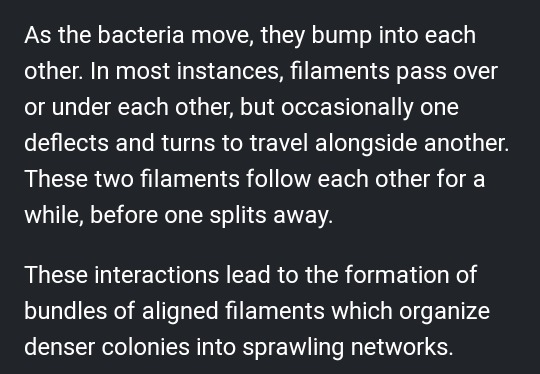
AAAAAAA
THEY LITERALLY JUST DECIDE YES THIS ONE IS OKAY AND HOLD ONTO EACH OTHER
They hold onto each other and form a community like we do I'm totally not sobbing over this
#Yes im romanticising bacterial life#It's Tumblr after all#What if we were two cyanobacteria and decided to hold onto each other#Life imitates life#biology#science side of tumblr#cyanobacteria#algae
136 notes
·
View notes
Text
WALKING would NOT EXIST without Cyanobacteria
The first organisms to "walk" (on land) were likely Arthropods, similar to today's millipedes. Arthropods were also likely the first organisms to develop legs. Tetrapods (4 legged Chordates) later convergently evolved walking on land, as did many other species. The common ancestor of all of these species is the Ur-bilaterian (the first animal to have two sides). The Ur-bilaterian breathed O2, and the vast majority of O2 that exists on Earth was produced by Cyanobacteria. Therefore, it would not be possible for walking to have evolved without Cyanobacteria providing O2 to those first early walkers.

86K notes
·
View notes
Note
not a desert technically but I just visited the dunes in Monterey and gleefully trampled on some ice plant and I feel like you might enjoy that. if you wanna talk about the kinds of vegetation that grow in sandy soil or something I invite you to 👀
(also you're doing it! you're surviving! you'll get through that doctorate!)
ok ready this is my most important soapbox of all because soils in the desert are very special and have such cool organisms you don't find in these arrangements outside of drylands...
first lookee here. wauw beautiful utah
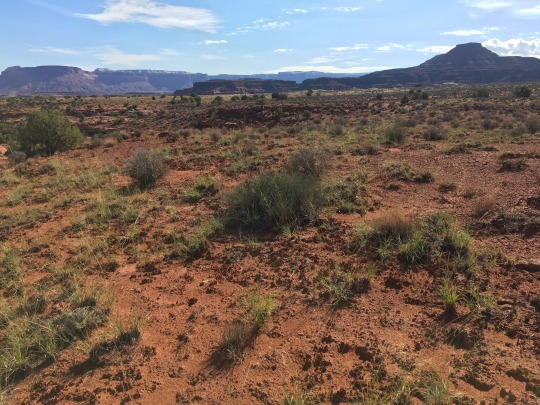
ok now look closer
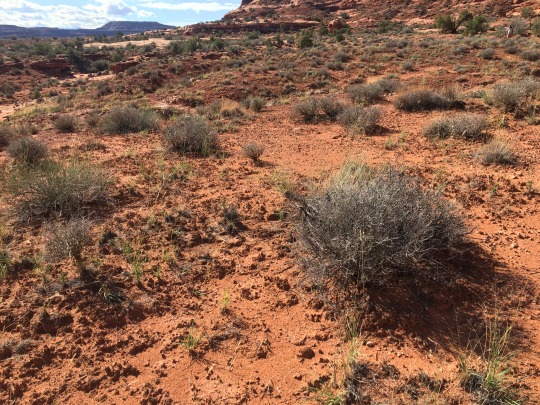
no closer closer closer
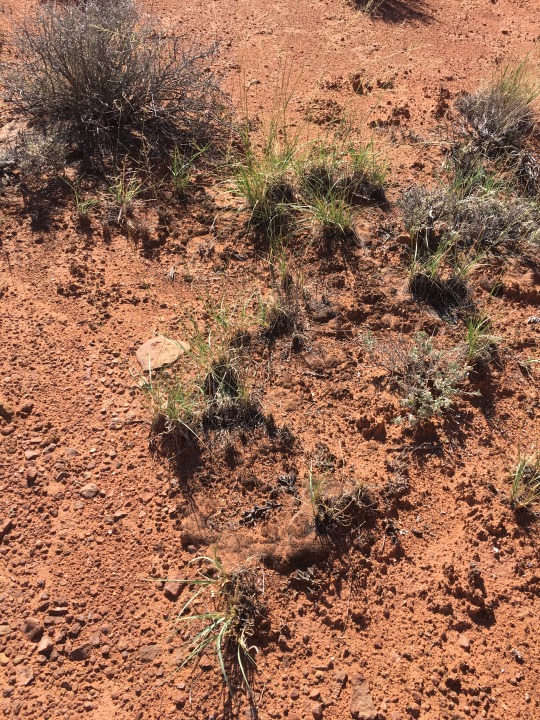
CLOSER CLOSER CLOSER

WOW is that MOSS? you are thinking. the answer is YES. but doesn't moss like lots of water you are thinking??? WELL USUALLY. BUT in the desert you will notice that things like grasses and shrubs have lots of space between them unlike in more temperate climates-vegetation cover is not truly continuous. And there's less leaf litter than in forests obscuring the dirt. Which means all that soil is just sitting out in the open with nothing to protect it from being blown away by those harsh desert winds... except of course for our friends the BIOLOGICAL SOIL CRUSTS. also known as crypotbiotic soils, cryptogrammic soils, and biocrusts (for short).
These are communities of mosses, lichens, cyanobacteria (aka blue green algae--yes, those are usually Wet too, but ironically so so common in deserts), and the tens of thousands of surface and subsurface microbes that are associated with them. It's easy to forget just how many organisms are living in one single scoop of soil, especially because science can barely identify 1% of these microbes. Like of JUST the ones we have enough info to classify enough to count in my own master's dataset left me with over 25,000 unique taxonomic units I had to manage. don't worry about what that means just know it was very annoying and makes statistics a headache. anyway you find them all over the southwest US states as well as in other deserts around the world (spain, australia, sooo many in china, incredible ones in the succulent karoo in south africa/namibia, plenty in argentina etc etc), if you know where to look...
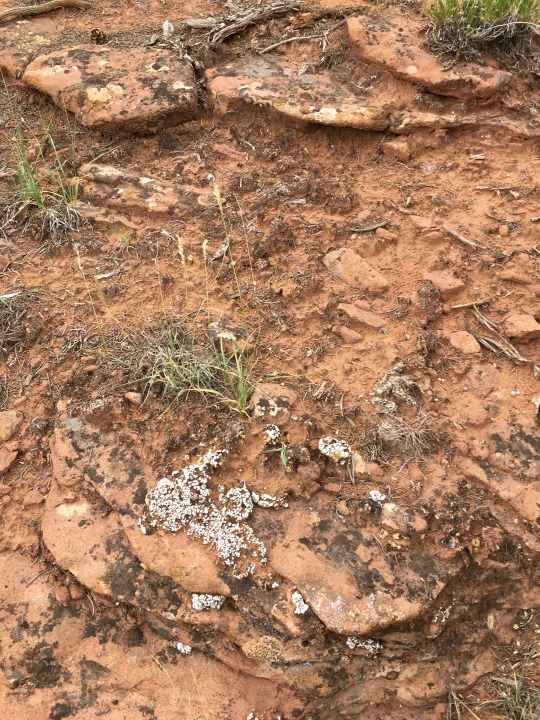
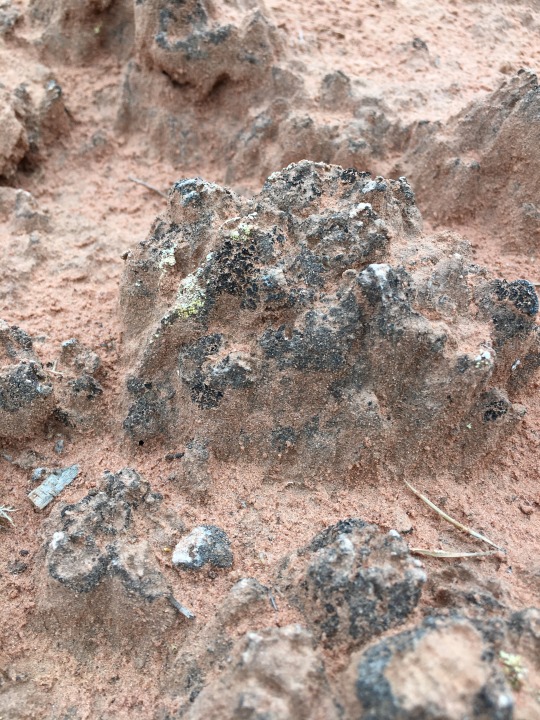

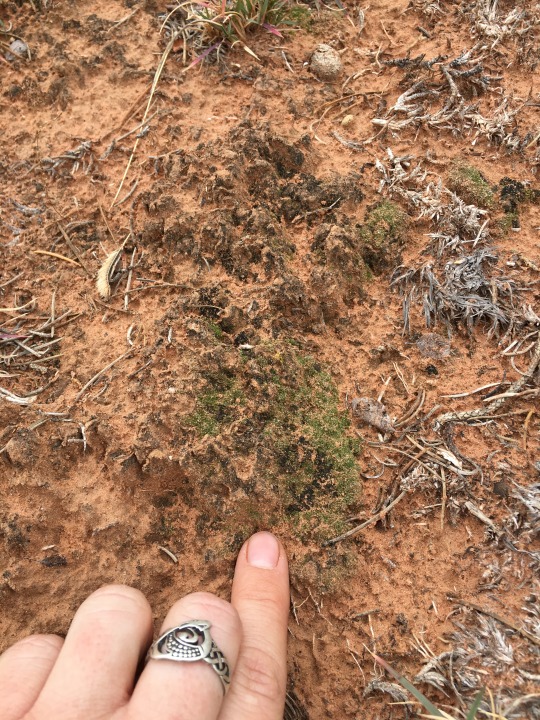
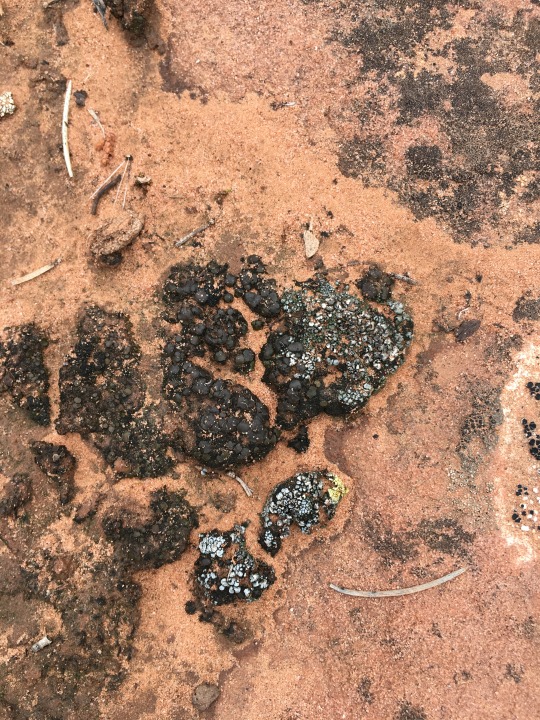
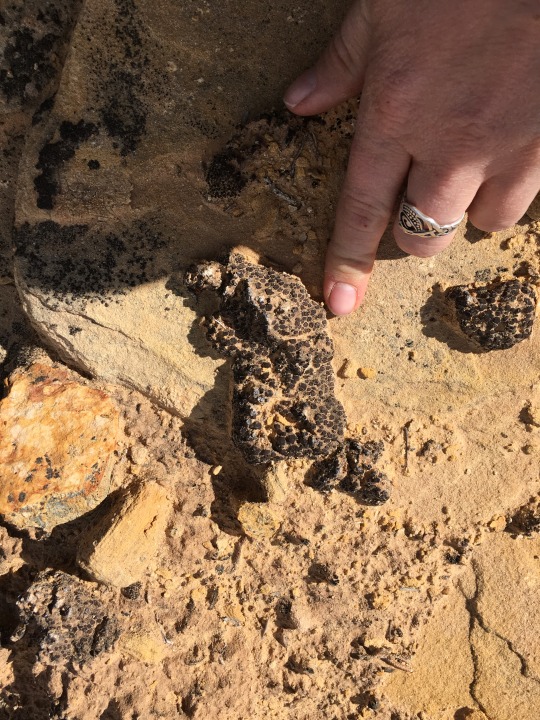
anyway OUR HEROS THE BIOCRUST aren't just there to look pretty (though you will can see from photos they also do this :) ), but are a vital component to the dryland ecosystem! They literally hold the soil surface together to prevent erosion, they influence hydrology in terms of rainfall runoff + infiltration, they impact how seeds germinate, they contribute to nutrient cycling and what plant-available compounds are held at the soil surface... like i feel like Tumblr in general has been made aware of how fungi & root networks interact in large scale systems like forests, but that is also happening on a more microscopic level in deserts! just in the top couple centimeters soooo much is happening. Cyanobacteria in particular are tiny organisms that produce little nets of sugars woven in the soil to climb around on and protect themselves, and if you crumble a little bit of soil from the surface you can see how the little spiderweb strings literally hold together the sand particles.
Now that you're Aware of biocrusts, when you look at larger scale landscape photos taken in un-trampled areas of desert, you will notice them as darker patches and textures on the lighter soil:
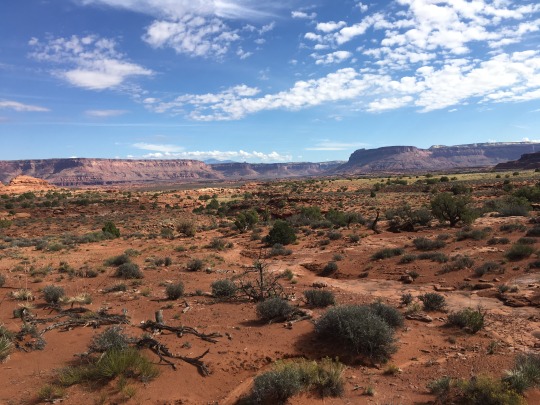

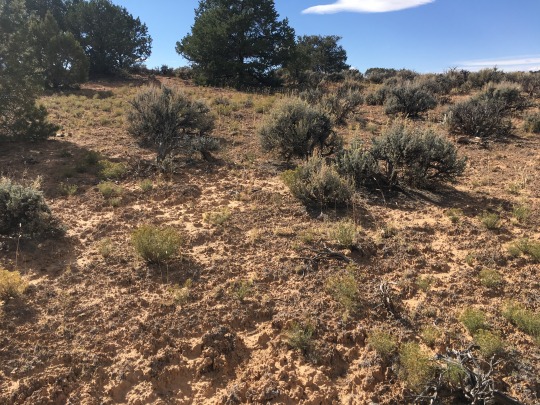
Yep there's these tiny little communities all over, that many people never learn to see. And now what I said before about mosses & cyanobacteria usually preferring wet environments--they have in fact adapted to life in the desert in ways that means they're dormant for most of the year. They live in stasis until the rainy season hits (or in some cases, winter moisture from a snow layer--many will photosynthesize through a few inches of snow since it's clear/white), and then burst into color and life. Many patches of biocrust will look utterly lifeless and dried out at first and then become vibrant and swell up within a few minutes of being exposed to moisture. Lichens, while more vibrant even when dry, will also mostly only grow/reproduce while wet. And biocrusts come in all sorts of colors, shapes, and preferred microhabitats!
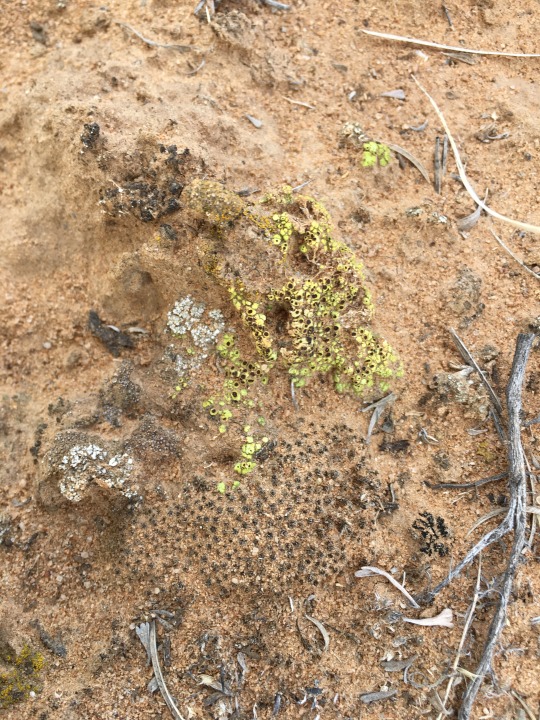
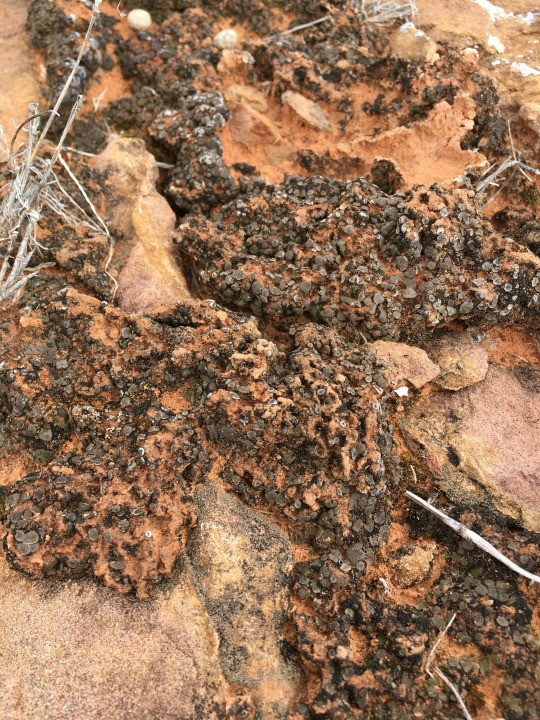
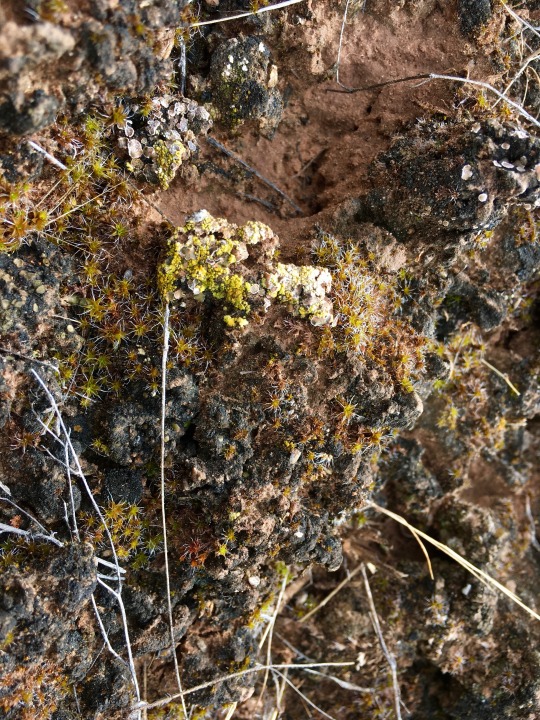
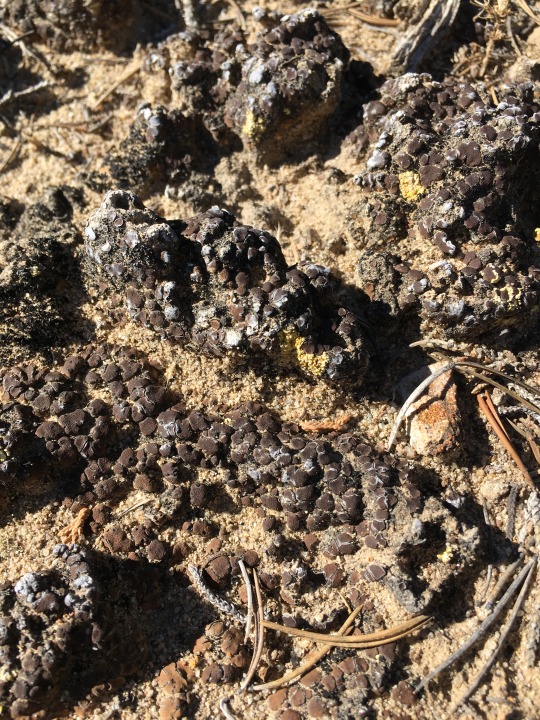

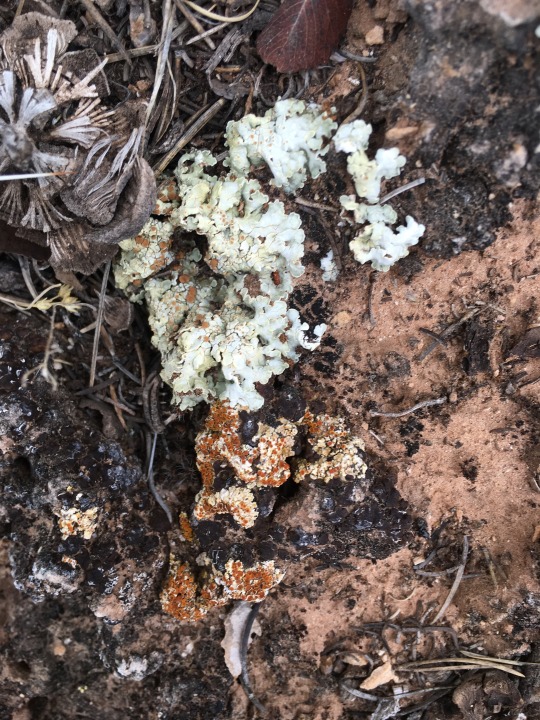

anyway this post is long enough already so i'll be quick. while beautiful and important as you can imagine these are FRAGILE. if they get trampled too much, by humans or cows or cars, that's it. you're back to bare soil that can blow away whenever it wants.
I was lucky to get to participate in a 2x/year survey of one of the very few places in Utah to NEVER have cattle grazing or development, a remote area the entrance is kept secret to inside Canyonlands National Park, where you can see just how dense and lush biocrusts once could be in the US southwest:
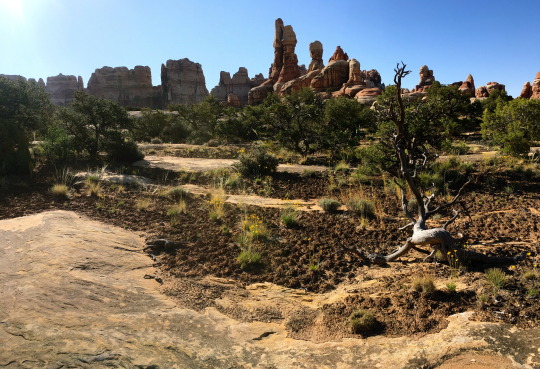
ah... glorious. what special little guys. this is why if you visit many of the national parks in Utah you will see signs & stickers around with slogans like "Don't Bust The Crust" and "Tiptoe Through The Crypto" and etc. so heed that advice but DO stop and kneel down and get a better look at them!
#LONG POST#if you dont like long posts you can turn on the collapse posts feature in settings fun fact dont yell at me for your own dash choices#deserts#desert southwest#biocrusts#biological soil crusts#now if i could get myself onto a videogame design team you'd bet id put THESE in those desert regions#its fantasy land give me beautiful fantasy biocrusts... so sad to see them all extinct in thedas how many druffalo did they graze... anyway#replies#ramblings#dreadfutures#i spent a beautiful weekend in monteray once. for a conference but i skipped a day to go to the aquarium and sea kayaking which was great#didnt get to go to the dunes but DID get to jump in the very cold ocean a bunch which is always a treat for a desert rat#all photos mine btw thats why theres no credits
60 notes
·
View notes
Note
Whats the difference between lichen, moss, mould and mushrooms if they're all fungus? Aren't they all the same sorta thing?
so, interestingly, all of these groups are very different !! instead of naming the differences, let me quickly explain what exactly these organisms are.
lichen :
lichens are symbiotic organisms, meaning they are in themselves the product of a relationship between different organisms. to simplify it, lichens are big part fungus, & smaller part algae (protista) or cyanobacteria (monera). these different forms of life together create lichen, which grows on trees, rocks, leaves, mosses & sometimes other lichens !! to read more about lichens, check out @/lichenaday's blog :-)
moss :
mosses are actually not fungi at all !! they are small, flowerless plants. they grow on trees & in soil. :-)
mould :
mould is a type of structure that fungi can form - it is entirely fungal. it reproduces through airborne spores :-) there are many different types of mould ; some are toxic, some are used medicinally, & some are saprotrophs. (note : slime moulds & water moulds are unrelated to fungal moulds !!)
mushrooms :
so, lots of people think mushrooms are a species of fungus, but they are not. "mushroom" refers to the fruiting body of a fungus ; what a mushroom is to a fungus is comparable to what a flower is to a tree - the part that reproduces !! not all fungi produce mushrooms (e.g. moulds, which do not have fruiting bodies as the entire organism is able to release spores). there are currently only 14 000 discovered fungi that produce mushrooms !! more fungi that don't produce mushrooms include mildew, yeast & lichen.
so, yes !! they're all quite different in structure, cells & function in the ecosystem.
#please let me know if i should explain any of these further - i'm always happy to !!#except moss.. i'm not really a bryology expert ^^"#but the rest i am more than happy to continue about !!#• askbox replies: •#(ask : luminousmoon21)#||#fungi#fungus#mycology#mushrooms#mushroom#earth#nature#science#moss#lichen#mould#mold#slime mould#plantae#protists
577 notes
·
View notes
Text
Delicious in Dungeon in The Kitchen
So... I was struck by the thought that I kinda wish some food nerd would go through the Dungeon Meshi dishes and analyze them and sort of give a "this is the real world thing they're making" run down.
And then I realized I'm a food nerd that can do research.
So.
We're gonna try this out, starting with Volume 1. I don't promise that I know everything about cooking. I don't promise I'll always be able to make the thing I'm looking at (I am broke, and I don't have my own kitchen). But I can at least look at a dish and figure out what they're doing and how to replicate it, at least sorta.
Dungeon Meshi Volume 1-- Huge Scorpion and Walking Mushroom Hot Pot

The two main components of this dish are the Huge Scorpion and Walking Mushroom.
Walking Mushroom
Looking at the images in the manga, Walking Mushroom seems to just... be a mushroom that can walk around. There are no organs, the interior seems pretty uniform in substance...
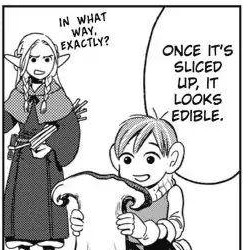

Like, literally, that's exactly what sliced mushrooms look like. Senshi cuts the mushroom into ~4" strips (judging by their size next to the small cabbage-like vegetable, and comparing those plants to his hand in the image of him gathering them. I am assuming dwarf hands are roughly the same size as human hands).
There's a variety of edible mushroom that is probably as close as we're going to get to the size of a Walking Mushroom, growing a cap up to 3' wide, but it seems to only grow in termite mounds in a very specific part of the African continent (please forgive my USAmerican, White education leading me to not being able to identify the specific region), so... if you can get that at all, it's probably crazy expensive (as it should be, unless you're literally getting it from the mounds or local markets yourself). Portobello or similar large culinary mushrooms are probably just fine. The Mushroom Feet are literally just mushrooms, so no worries there.
Huge Scorpion
Ok, so... there is a difference between arachnids and crustaceans. As a start, arachnids have book lungs and crustaceans have gills. Arachnid guts are different from crustacean guts, just because of environment. Hell, crustacean limbs grow differently from arachnid limbs.
That said, everything I see in Dungeon Meshi implies that, from a culinary standpoint, Huge Scorpion is a crustacean-


So, really, it's just a big lobster. Take a lobster, cut off its legs, antennae, and the tail fluke, and you're going to see something that looks pretty similar to the huge scorpion in Dungeon Meshi.
Seaweed
Next is seaweed, which... is just a thing, but also kind of an imprecise term, I think. Basically, "seaweed" just refers to any marine algae that is multicellular and macroscopic (big enough to see). Arctic Moss seems to be a real thing which refers to a couple things- the aquatic moss Calliergon giganteum and the terrestrial lichen in the genus of Cladonia, which includes Reindeer Lichen.
Reindeer lichen is edible, in a number of ways, but it's also not seaweed. So we look at Calliergon giganteum. I cannot get an answer as to whether this particular variety of moss is edible. So... fuck it, say Senshi used Reindeer Lichen, at least we know that's edible.
"Star Jelly" is... I don't know. The main result I find when googling it is that it's the sort of general term for various slimes that show up on lawns and other vegetation, etc. Which means it could be anything from amphibian spawning jelly to who the fuck knows what.
However, one thing it could be is a cyanobacteria known as Fat Choy, a commonly used "vegetable" in Chinese Cuisine:

Looks like jelly? Yep. Looks weird enough that you might imagine it comes from a star? Yep. Edible? Yes!
(I mean, maybe don't eat a ton of it, or get it from irreputable sources. At least some Fat Choy contains a toxic amino acid which may or may not have negative health effects, but I'm not a doctor, so all I'm saying is "be aware of this." It's an expensive delicacy, which means that it is a particularly lucrative target for counterfeiters, and China does not have strong, or strongly enforced, food safety laws).
The Hard Stuff
So that leaves "Invertatoes" and "Dried Slime."
Neither of which seem to have a good direct analogue to the real world. Well... sorta.
Invertatoes seems to refer to the plants. The name calls to mind potatoes, and potatoes do indeed grow in the ground and are starchy. It's probably fair to just use any kind of starchy tuber as the "invertatoes." Maybe cassava, since those are large enough that it's at least somewhat believable that "Fantasy Land Cassava" could look like that (although that doesn't fit the "these are normal plants that grow upside down" unless we're being really generous).
The problem is that it's sort of implied that the cabbage-like vegetable seen in the hot pot comes from the same plant, and everything from a potato plant other than the potato itself is toxic. They also don't look like that.
I literally don't know what those cabbage/lettuce-like leafy vegetables are. They're not seaweed, because the two varieties called out definitely don't look like that. They're not, so far as I can tell, the greens of any kind of starchy tuber--
EXCEPT.
So, I was taking one last look at tubers to see if I could find something that seemed to match, and I think Invertatoes could be likened to something similar to chicory. Particularly endives. I never knew endives were related to chicory (ie, "that thing that I'm aware is popular as a coffee substitute in the South, but I don't have much desire to try it, and I wonder if it even has caffeine..."), but, apparently, yeah. Endives are a member of the chicory genus.
So, yeah, lets say that Invertatoes are a sort of fantasy plant similar to the various members of the chicory genus. The trunk can be replicated with chicory root, and the leaves with endives.
That leaves Dried Slime. Dried Slime makes up the noodles in the hot pot, which implies that the noodles are gelatinous, and probably low in gluten. Senshi's explanation of the slime makes me want to think of it as a macro-unicellular lifeform, but... I'm not sure that's accurate.
While it's definitely not an accurate way to describe a jellyfish, I could definitely see a non-biologist describing jellyfish in a way similar to the way Senshi describes the slime. I could also see some fantasy terrestrial jellyfish thing hunting in a similar manner to the slime. Moreover, there are edible varieties of jellyfish, and they're processed in a manner very similar to what Senshi describes for processing slimes. And one way of preparing edible jellyfish is to thinly slice it into noodles.
Hot Pots
I... think this is using a very specifically Japanese sense of "hot pot" (which makes sense), because in Japan, hot pot can refer to a dish called nabemono, while in general, hot pot refers to a particular kind of dining in China where you get a pot full of boiling stock/broth and a bunch of raw ingredients, and you put the stuff you want into the broth at the table. Nabemono is more of "put a bunch of stuff in a pot, and cook it. Serve it boiling." Which is to say, it's soup.
Senshi puts the scorpion meat and mushroom into a pot on its own, and lets it start boiling-

Then, while it's boiling, he goes and finds other ingredients, coming back with the invertatoes and the slime. The two are prepared simply-

Seasoning isn't included in the ingredients, but I can understand this as a choice for presentation. We do see Senshi add something to the broth after tasting it, and I think it's fair to assume it's one of soy sauce, mirin, fish sauce, or similar. I think it's actually really interesting that we see Senshi add seasoning, but we're not told what it is-

Because... that's cooking. You can follow a recipe, but ultimately, you need to taste your cooking and make your own decisions. Senshi lets the soup cook, tastes the broth, decides it needs something, and gives it a bit of time to let the flavors meld before serving it up.
Dungeon Meshi Lobster and Mushroom Hot Pot
So, we're looking at something like this for the "Huge Scorpion and Walking Mushroom Hot Pot"--
Lobster- ~5 lbs or more (a 1 lb lobster yields about 4 oz of actual meat, which is a single serving), cut into large slices
Portobello- 2 mushrooms large diced, 2 left whole with the caps scored
Reindeer Lichen and Fat Choy- to taste
Chicory Roots- ~1 cup, diced
Endive greens- ~2 cups
Jellyfish, thin sliced- as much as you like
Add lobster and mushrooms to water, and allow to boil. While it comes to a boil, prepare the other ingredients, then add to the water. Let the soup come to a full boil, then reduce heat and simmer for 15 minutes to an hour (can simmer longer, but this will affect the texture of the ingredients. Longer simmering will result in more melding of flavors, but also degraded solid parts).
Taste the broth. It will likely need salt and acid, which could come in a variety of forms, such as kosher salt and lemon juice, soy sauce and mirin/rice vinegar, oyster/fish sauce, or something else. Go with your gut and your taste buds..
#Dungeon Meshi#Defictionalization#Cooking#Food#Huge Scorpion and Walking Mushroom Hot Pot#Lobster and Portobello Hot Pot#This actually isn't really my thing due to the mushrooms but hell#Cashapp: $ValravenApocalypse#Paypal.me/Korbl#Ko-fi.com/valravenapocalypse#If this gets 100 notes and people like it I'll do the carnivorous plant fruit tart#Delicious in Dungeon
106 notes
·
View notes
Text
CHAINS would NOT EXIST without Cyanobacteria
Even putting aside the fact that humans (who breathe atmospheric O2, the vast majority of which was created by Cyanobacteria) were the inventors of chains, even this material from which the chains themselves are composed would not exist without cyanobacteria.
Why, you may ask? Because these chains are covered Iron Oxide, aka rust, which can only be created by Iron being oxidized. What does being oxidized require? Atmospheric O2, the vast majority of which was created by Cyanobacteria. In fact, literally any mineral which contains Oxygen would not exist without Cyanobacteria.


65K notes
·
View notes
Text

davg spoilers
talking with @skip-the-clumsy-dragon about this has led me to really thinking it through, and i want to explore how dragon age can be viewed through an ecological/environment lens
particularly with respect to the actions solas has taken in the far-distant past and what he wants to do in the present
the veil as an inciting factor for a trophic cascade... the removal of the veil as an inciting factor for another trophic cascade...
the dissonance between a desire to restore and a desire to preserve. how sometimes preservation can mean maintaining the status quo; how sometimes restoration can mean destroying much - or even all - of what has supplanted what was
how complex the morality is in either situation. how the whole system needs to be analyzed, and how unethical it is to analyze the whole system, come to a conclusion, and implement it. the brutal mathematics of it all. the no-good-answer, only degrees of bad
restoration in dragon age means one thing for sure, but has many other possibilities
what it means for sure:
the veil and the 'waking world' will be connected again
what it might mean:
magic restored to the elves
magic restored to the dwarves (possibly?)
the titans could reawaken
spirits/demons are safer and less likely to be altered
what it will damage for sure:
the present world (the how remains unclear)
what it may damage:
mortals - both people and animals
landscapes
built environments and societies
existing cultures
as an example of this on a much smaller scale: a pond.
a pond is a habitat, teeming with life. many things are reliant upon it. but over time, nutrients build up in ponds until they become overwhelming. this leads to algae blooms, yes, but also to lower levels of oxygen in the water, lower levels of light penetrating the pond, and a further process of decomposition/nutrient dumping as the algae decays
on top of making the pond itself uninhabitable for some things, certain types of "algae" blooms - especially "blue green algae," or cyanobacteria - can make the water unsafe for non-aquatic creatures. it can be very dangerous for animals to drink from or go into water that has a cyanobacterial bloom
so sometimes, to preserve a pond as a habitat, one needs to get in there and destroy a lot of it. remove a lot of the algae, for one, but it's difficult to do that without destroying or harming some of the life that exists right then and now
the bugs, the tadpoles, the little near microscopic invertebrates you can't see but are definitely there... and you are of course destroying plant life
so do you let the whole pond die, become uninhabitable to anything and everything, or do you restore it, and know that in doing so, however hard you try to preserve the life currently there, you will inevitably end up destroying some of it?
so, am i comparing people with near-microscopic invertebrates? no. but this is a simple example of what i think solas' whole pov boils down to: does he let the world cycle into a slow death, with significant harm done along the way, or does he - doing his best to limit the damage - change it all at once, believing that it can be stabilized this way, that it is inherently more sustainable?
i don't know which way is more sustainable. none of us do. that's part of the underlying conflict of the game, that uncertainty, but i never got the impression that he's just out there trying to restore the glorious city of arlathan or whatever. he's out there specifically trying to restore the entire world to what it once was, and what he feels strongly that it should be. he is trying to preserve its inherent nature
and of course, this is not my discovery and i don't know who first figured it out or shared the information so i can't credit, but it's worth pointing out:
Solastalgia is a term coined by philosopher Glenn Albrecht to describe the emotional or existential distress caused by negatively perceived environmental change.
as a final note: i said i am not comparing people to near-microscopic invertebrates, but i don't think solas is doing the equivalent, either. perhaps at first, but that is dispelled as he spends time in the inquisition, as he gets to know the people of this age
yet the complexity remains. and it isn't clear-cut; there is harm to both sides, and good to both sides. it is painfully, gloriously complex, a narrative that has no single clear answer
#broodmeta#brood davg meta#yes i changed my banner#bc i beat the game now so#yknow#spoilers are no longer an issue#davg spoilers#da4 spoilers
42 notes
·
View notes
Note
re: the boltzmann brain thing there is a SIMILAR thought experiment called Last Thursdayism thats another one of those silly unserious "probably definitely not true but also you cant really Prove it isn't true" things that says "what if the universe just suddenly popped into existence last thursday, already in its modern state and with all of your past memories already in your brain?" just thought i would bring this one up because a Last Thursdayist universe WOULD have cyanobacteria in it... but whether other things would exist without it is kind of a funny question. like the cyanobacteria wouldnt have caused things to exist, because the things just popped into existence, but also the retroactive (is retroactive the right word here?) constructed history of the things DOES require that cyanobacteria would have been there, if the history did happen... what do you think? would a Last Thursdayist version of our world require cyanobacteria?
A LAST THURSDAYIST VERSION OF OUR WORLD would NOT EXIST without CYANOBACTERIA
So, in a Last Thursdayist version of our world, it is true that we can't factor the existence of atmospheric O2 into the equation of whether things require Cyanobacteria. Although in our world, Cyanobacteria caused all atmospheric O2 to exist (and thus also caused everything that uses that O2 to exist), in a Last Thursdayist version of our world, all of these things would have just spontaneously come into existence.
However, there are a lot of things on Earth which require Cyanobacteria to exist, even without atmospheric O2. For example, plants! Plants, even to this day, literally contain Cyanobacteria in the form of Chloroplasts. That's what they use to photosynthesize! Even if the Earth was created last Thursday, it would have devolved into utter chaos by today without these Cyanobacteria, and most macroscopic things would already be dead.
So, be thankful for Cyanobacteria, no matter how you think the universe came to be what it is today! Whether you're a brain in a box, whether you popped into existence last Thursday, whether G-d created you from clay, whether you evolved from LUCA, you should love Cyanobacteria all the same.
Because our world could not exist without them.
13 notes
·
View notes
Text
This PILE OF SPINACH WITH A DONUT ON TOP would NOT EXIST without Cyanobacteria!
Spinach is a plant, meaning that it produces its energy through photosynthesis. Photosynthesis takes place in the chloroplasts, which are actually Cyanobacterial endosymbionts (Cyanobacteria which live inside of the plant). Without these Cyanobacteria, plants (including Spinach) would be unable to produce energy or grow.
This donut also would not exist without Cyanobacteria. Donuts contain many ingredients derived from plants, such as flour, sugar, and the jelly that likely lies at this donut's center! All plants contain photosynthesizing Cyanobacteria which produce all of their energy.

breakfast
50K notes
·
View notes